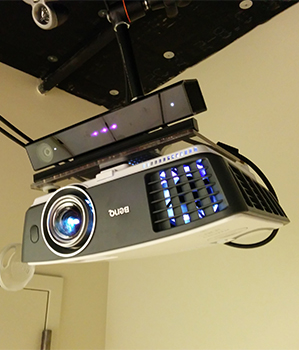For those of you familiar with conference calls, chances are you’ve wondered what the person you were speaking to looked like and may have pondered what they were doing during the meeting. Enter Room2Room, a Microsoft Research project that’s planning to answer these questions by perching a life-sized 3D projection of the person you’re chatting with on the empty chair across from you.

Room2Room from Microsoft Research can perch a life-sized 3D projection of the person you're speaking to on the phone in the chair across from you. Image source: Microsoft.
By using Kinect depth cameras and digital projectors, the equipment can capture the image of a person in 3D in one room and project a life-sized version of that person in real-time onto a piece of furniture in another room, where someone else actually is sitting, and vice versa. This way, each person can see a digital image of the other with the correct perspective and interact accordingly.
Building off of an augmented reality project called RoomAlive, which uses Kinect depth-sensing cameras and digital projectors to create a room-sized augmented-reality gaming arena, Microsoft Research is attempting to advance the technology with Room2Room. Instead of setting up just one room, Room2Room sets up two similar ones so they can scan an individual sitting in each room and project the image into the other room.
To get a sense for how well people could communicate this way, seven pairs of study participants built three-dimensional shapes with blocks through augmented reality. For example, one person was seated in front of a table in one room with the actual blocks, and their partner sat in another, giving instructions for what kind of shape to conduct. Each person was projected into the other’s room in order to work together.

A Kinect depth-sensing camera and a digital projector. Image source: Microsoft.
Though it was a success, there are still issues to solve before Room2Room is likely to show up in conference rooms and living rooms. During the study, researchers found that while the participants put together their puzzle, it took four minutes when face-to-face, and it took about seven minutes using the augmented-reality system. Another problem is that even though the depth-sensing and projection hardware is available, currently the system is bulky and can take some time to set up.
It’s expected that the resolution of real-life projections will also be improved in the coming years. Because of the growing public interest of augmented reality, along with consumer-geared headsets from companies such as Oculus, there may a day where we can say goodbye to awkward remote communications while welcoming more responsive, productive conference calls.
Sources: Microsoft Research, PSFK
Advertisement
Learn more about Electronic Products Magazine





